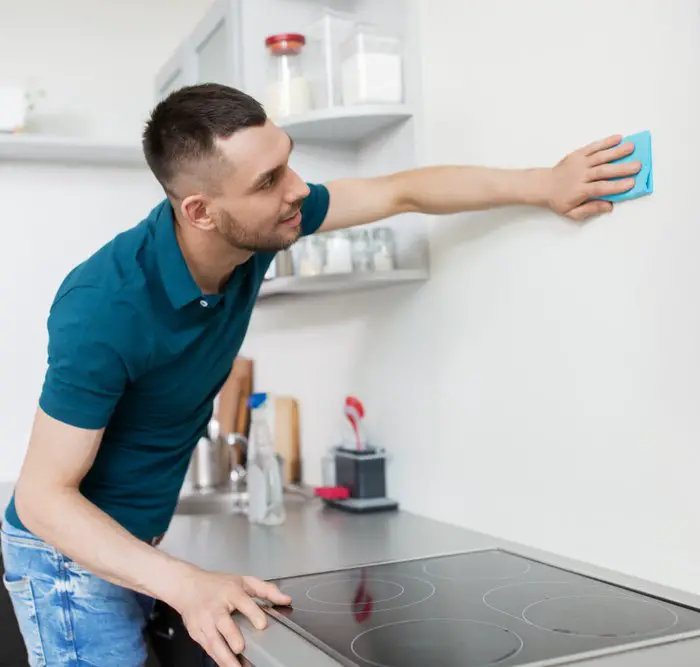
Oil-based stains are notorious for being difficult to remove from painted walls. In fact, many times the paint will start to chip and peel away in addition to the stain.
When cooking at home, you frequently deal with oil splatters, which can leave oil stains on the paint of your walls, destroying their overall appearance. Fortunately, you can remove these stains with vinegar, normal dish soap, baking soda, or even iron heat.
It will be easier to remove stains if your walls are painted in a semi-gloss finish. Unfortunately, oil stains can be difficult to remove from flat-finished walls or unfinished wood paneling. In these circumstances, touching up the paint is frequently the best solution.
Methods for Removing Oil Stain from Painted Walls

Several products are specifically designed to remove oil stains. If you don’t have one, you may make do with some common household items you undoubtedly already have.
White Vinegar
Vinegar is one method for removing oil stains from painted kitchen walls. Fortunately, you can probably find some in your own kitchen.
Pour some directly from the bottle onto a sponge and dab it over the stain. Vinegar includes acetic acid, which aids in the breakdown of oil and grease.
Here’s a step-by-step guide for removing oil stains from your wall’s paint with vinegar.
- If the oil stain is still new, take a paper towel and blot as much oil as you can from the wall.
- Soak a sponge or a clean, non-abrasive cloth in vinegar and apply to the affected area.
- Allow 3 to 5 minutes for the vinegar to permeate the stain and make removal easier.
- After the allowed time, gently rub the oil stain using the same towel. Applying too much pressure to the stain may cause harm to the paint.
- When the oil stain has lightened noticeably, take another clean cloth and dampen it with clean water.
- Wipe away any remaining vinegar residue on the wall.
- Finish by wiping the area clean and dry with a clean, dry cloth.
Removing oil stains with ordinary dish soap
Dish soap is incredibly good in cleaning dishes as well as oily pots and pans. Given this, it will surely remove these greasy oil spots from your painted wall. Surfactants in dish soap help it to quickly break down oils. It is also soft enough on your paint to not damage it.
Do these simple steps:
- Soak up as much oil off your wall as possible with a paper towel.
- In a mixing bowl, combine 1 tablespoon dish soap and 1 cup warm water. Warm water aids in removing the oil from the wall.
- Using a clean cloth or sponge, dip it into the solution.
- Gently scrub the stained area until the stain is visibly lighter.
- Wipe the dish soap residue from your wall with a clean towel dampened with clean water.
- Dry your oil-free wall with another clean cloth.
Baking soda can be used to remove oil stains.
Trying to get rid of old and dried oil stains from painted walls can be difficult, but baking soda will instantly take off the persistent oil stain. Baking soda’s alkali quality helps it to easily cut through oil stains and other dirt deposits on your wall.
This is one of the most convenient cleaners because it can be found in virtually all household kitchens and almost all grocery stores in your area.
How to Remove Red Wine Stain from Painted Wall
How to use this method:
- To get a paste-like consistency, combine 3 teaspoons baking soda and 1 cup warm water.
- Apply your homemade paste cleaner to the stained area. Allow it to soak for 5 to 10 minutes, depending on the intensity of the stain.
- Scrub the baking soda paste into the stain gently using a nylon scrubbing sponge. This will allow the baking soda to penetrate the stain on your wall, making eradication easier.
- After you’ve removed the oil stain, use a damp clean towel to rinse the treated area with clean water.
- Dry your wall with a clean, dry cloth after removing the baking soda and oil stain residue.
Flat Paint
Removing stains from flat paint frequently results in a worse stain than the one that was removed. One approach to avoid this is to apply heat to the stain. Place an absorbent cloth or several paper towels over the stain and iron the cloth on the lowest heat setting. The heat may emulsify the oil sufficiently to allow it to seep into the cloth.
Frequently Asked Questions
Conclusion
Wall paint is an important component of your home’s décor, and you don’t want these dark, unsightly oil stains to detract from it. Fortunately, you can always rely on these simple and effective oil stain removal procedures to restore the beauty of your wall’s paint and keep your walls clean and stain-free.
